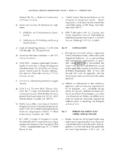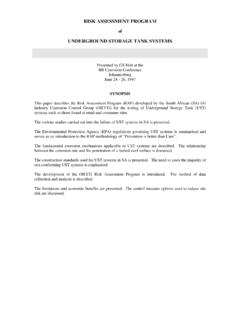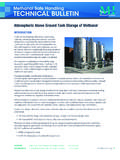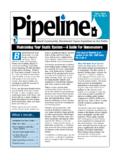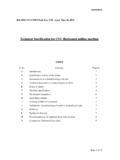Transcription of for Precast Concrete Septic Tank Installations and …
1 technical Advisory Council for Onsite Wastewater Treatment Advisory for Precast Concrete Septic Tank Installations and Inspections Approved by the technical Advisory Council December 6, 2006 Precast Concrete Septic Tank Installations and Inspections 1. Excavation: a. Tank should have a minimum 18 clearance around all sides for proper placement and back filling (Fig. A & C). Proper use of bedding material is critical so as to provide a uniform bearing surface to ensure the tank will not be subjected to adverse settlement.
2 Use a minimum of 4 of granular (sand or pea stone ) bedding overlying a firm and uniform base unless otherwise specified. tanks should not bear on large boulders or rock edges. Set the tank level to provide the proper elevation drop from inlet to outlet (Fig B). Proper use of bedding over undisturbed soils ensures the tank is set level and stays that way. Fig. A Fig. B 2. Burial Depth and Loadings: a. Most standard Concrete Septic tanks are not designed for burial depth in excess of 3 feet of cover over the tank (Fig C).
3 tanks used for deep burial or traffic loadings should be specially designed for the intended use. 3. Concrete Tank inspection : a. Verify that the tank is of correct capacity and configuration as required. b. Joint sealing materials should be of high quality, preformed and flexible to achieve a watertight seal. Sealants conforming to ASTM C990 meet the criteria and should be of proper size for the joint of the Concrete tank. Apply sealants to form a continuous length of seal.
4 Properly splice the sealant by one of the following methods. Overlap splice: place one piece on top of the other and carefully mold together. Side by side splice: place ends in a parallel position and carefully mold together. Fig. C c. The connection between the pipe and tank must be accomplished with a watertight, resilient and flexible connector. These connectors are generally referred to as boots (Fig.)
5 D). Connectors conforming to ASTM C-923 fulfill this requirement. Fig. D d. Inspect the tank visually for any defect that may impair the use or life of the product. These may include cracks (Fig. E), honeycombed areas (Fig F), cold joints, etc. Repairs should be made using only materials that are specifically developed for Concrete repair; and make repairs according to the manufacturer s specifications. Fig. E e. A cold joint (Fig. G) is a joint or discontinuity formed when a Concrete surface hardens before that next batch is placed against it.
6 Cold joints require special care and, as a minimum, should include a high quality water-stop, bonding agent, and continuation of reinforcing between pours. ON TYPICAL RESIDENTIAL Concrete Septic tanks , A COLD JOINT SHOULD RARELY, IF EVER, BE OBSERVED. f. Verify the outlet device (pre-cast tee, plastic tee, effluent filter, etc.) is provided and of proper size and length. g. All access risers and covers must be structurally sound and watertight.
7 Riser covers shall be secured to prevent unauthorized entry. Fig. F 4. Backfilling: a. Care should be taken when backfilling, to prevent damage or misalignment to the entry and exit piping, the tank and fittings, and any joints. Back fill should be placed in uniform, mechanically compacted layers less than 24 thick. Compact one or two sides before backfilling the other sides. Excavated material may be reused for this purpose but should be free of any large stones, debris, or material great than 3 in diameter.
8 Heavy Concrete tanks are least likely to float in a flooded excavation. Concrete tanks will float, however, if the water level in the excavation is allowed to rise to a high level, causing potential damage to pipe connections and tank placement. To prevent this from happening, keep water pumped out of the excavation until after backfilling is completed, or fill the tank with water, or place soil on top of the tank. Fig. G 5. Tank Testing: a.
9 Each manufacturer and supplier of Concrete tanks should develop a quality control program that includes testing. The use of one of two primary test methods is recommended. b. Vacuum Testing: The recommended procedure is to introduce a minimum vacuum of 4 of mercury and hold the vacuum for five minutes with no loss (Fig H, I & J). Depending on the tank configuration, it may take some time to stabilize the vacuum level due to various factors (compression of sealant, temperature variations, etc.)
10 It is permissible to apply vacuum until the vacuum level stabilizes at 4 inches. Once vacuum is stabilized, remove the vacuum source and hold the vacuum for 5 minutes. If the tank fails the test, it may be repaired and retested. The suggested range of the gauge is 0-10 inches of mercury (maximum). Warning: Testing with negative pressure involves potentially hazardous conditions. It is recommended that the negative air pressure testing of Concrete tanks not exceed 7 inches of mercury, which is the recognized maximum requirement for structural strength proof testing.





